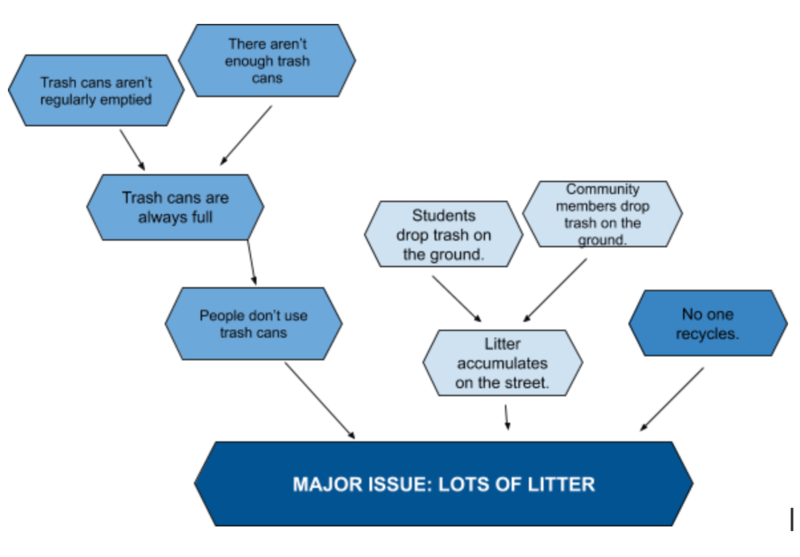This lesson is part of a series of lessons designed for educators to facilitate student-led inquiry around environmental topics. If there are time constraints, this lesson can be split into two at the Elaborate portion of the lesson. During Phase I of this series, students work towards identifying and learning about environmental topics.
You can learn more about this series here.
You can access this lesson plan as a Google Doc here.
You can access an example of student work as a Google Doc here.
Overview
Time: 100 minutes
Materials: Teacher-supplied news articles (local or national) on the environmental topic.
Guiding Question: What factors have led to/contribute to our environmental problem?
Objective: Explore the issue and clearly define the environmental problem
Engage
Time: 15 minutes
Making Flow Charts to Identify Knowledge Gaps:
Ask students what is causing this problem, and have them list all of the things that they already know. Challenge students to organize their knowledge into a problem narrative with a logic flow chart, such that A leads to B leads to C, which leads to the problem. These charts don't have to be linear, more than one issue can lead to the problem, and more than one factor can contribute to an issue. See below for an example.

Have your students take a critical look at the model they've created. Students should identify places where the connections between things are unclear, or where there are gaps in their knowledge. Encourage students to convert what they don't know into questions. Here's a continuation using our litter example:

Organize list of questions into 3-4 major topic areas. Split students into groups so that each major question has 3-4 students working on it. Here's how our litter example splits into topic areas.

Explore
Time: 25 minutes
Clarify Our Question(s):
In small groups, student should take a closer look at their major questions. Student should focus on:
- Break question down into small, concrete parts. Is there more than one question being asked here?
- Identify whether or not a question can be answered by research or through an experiment or observation.
- Identify what would be a satisfactory answer for a question.
- Brainstorm some places to start looking for answers.
- Does this question look for answers from peer-reviewed research?
- Would a community science project similar to yours be a good place to start?
- Might a local community group have the information you need?
Here's an example:

*Some classrooms may have students working on individual or small-group projects. Students can also work through the above tasks as individuals or small groups.
Explain
Time: 20 minutes
Research Students will take time to conduct research to find an answer to their questions that they've identified can be answered via research.
Summarize Students will write 2-3 sentence answers to their assigned questions. If the class is working on the same topic, these questions and answers should be compiled in a shareable format, such as a Google Doc all students have access to.
Sharing Student elect one person from each group to share the information they've learned about their topic.
Elaborate
Time: 30 minutes
Identify a Study Site Students should work together to decide on a location for their study site. Ideally, this site is near their school so that it’s easily accessible during the school day.
Write an Issue Brief Students will organize their information in the form of an Issue Brief to be shared on PublicLab.org. You can find more information on Issue Briefs here.
To format their Issue Briefs, students should focus on answering the following questions:
- What background information do you need to provide?
- This can be a place to summarize information you already know, give a brief description of your community, and give context for the issue.
- In one or two sentences, describe the main environmental concern you are working on.
- What are some of the obstacles you are trying to overcome?
- Are there known obstacles you have in understanding more about this issue right now?
- Do you have more information you would like to share for example, if you have any information about how the issue is currently regulated that could be helpful.
- Who is engaged in this concern?
- Are there other groups in your school, community, region, or country who are working on similar issues?
- What are the initial questions you would like to answer?
Once students have written up answers to these questions, they can fill in the Issue Brief template here.
Evaluate
Time: 10 minutes
As a group, students should come up with ideas around the following questions:
- What do we still want to know?
- Which of these questions are we able to build experiments around?
- What do we want to change as a result of our study?

1 Comments
@purl has marked @purl as a co-author.
Reply to this comment...
Log in to comment
Login to comment.